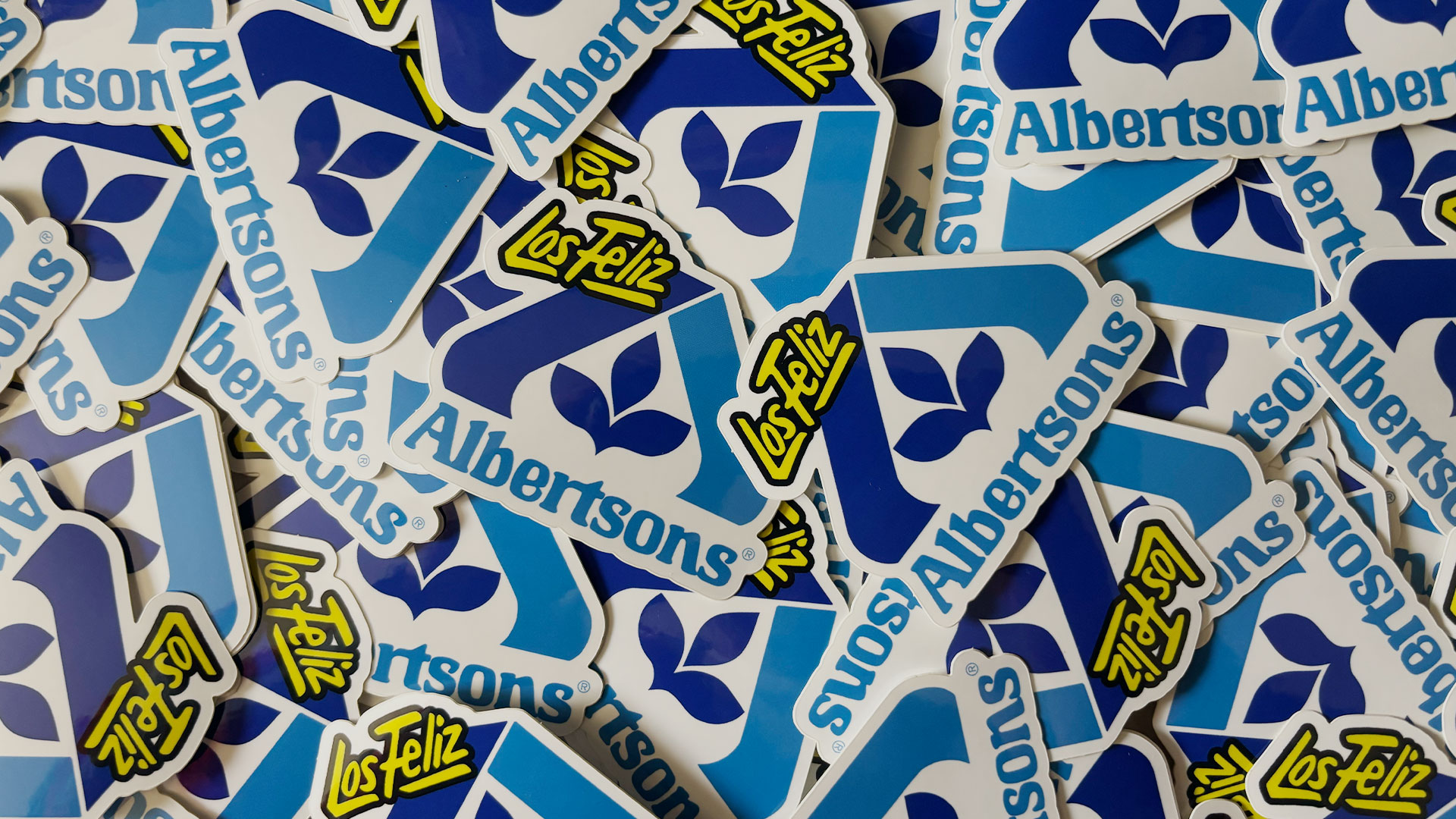What started as a simple Internet inside joke between two friends turned into a way to control a brand from the outside by using our authentic voices through modern ‘cave scrawlings’ etched on silica somewhere in Utah, accessed by millions of users all over the globe (memes). Or in our case, hundreds of people all over the upscale and artistic neighborhood enclave of L.A., Los Feliz.
Los Feliz Albertsons began as a goof. A trick. A scam… on my roommate. We live within walking distance of the grocery store and are there two to three times a week. Over the years, patronizing this market, we began to come up with backstories for the employees, spot celebs picking up their groceries, and observe the strange, unspoken rhythms that made this Albertsons feel less like a grocery store and more like the embodiment of the neighborhood itself.
One day, in an effort to clear away some boredom, I plotted to exploit my roommate’s wild imagination. I created @lfalbertsons on Twitter, intending to ‘casually’ imitate our favorite neighborhood destination—to his confusion and my delight. My first tweet was a sneaky photo of the mustachioed foreign bag boy, captioned: “Employee of the Week.”And we were on our way.
Eventually, I let him in on the joke, gave him the login, and we started tweeting back and forth under the same handle. It wasn’t until a year or two later that a former colleague—whom I hadn’t seen in quite some time—asked me at my birthday party: “Hey, have you seen this cool meme account from our neighborhood? It’s called Los Feliz Albertsons.” I told her: “That’s us!”
After that, we decided to take things slightly more seriously. We added a couple of key people and moved the project to Instagram—a far more visual-heavy platform where I could put my graphic design and video editing skills to work. The four of us developed the tone and voice for the brand, and, strangely enough, we actually made the store busier.By the time COVID hit, LFAlbertsons had become an unexpected touchpoint between the community and the store—even though we were never officially affiliated. Employees have reached out to us through Instagram, and they’ve had nothing but nice things to say. We’re always sensitive to their needs and have the utmost respect for the workers, vendors, and farmworkers who bring food to the markets and into your bags.
Corporate, on the other hand? I’ve seen job postings for Albertsons HQ in Boise looking for a social media manager – back when they had very little social media presence. I’ve applied. I’ve heard NOTHING. But hey—@lfalbertsons is on my portfolio.
I don’t think 7,000 followers is a huge number, but what I’ve learned from growing it has been invaluable. I’d love to share those insights over time, but the TL;DR is: there was no viral moment. No single post that skyrocketed engagement. Sure, some content performed better than others, but it was all about working on it piece by piece. A roaring fire starts with the smallest kindling.
The real strategy? Identifying a niche and wholeheartedly engaging that community. Without realizing it, we had painted ourselves into a corner of talking about groceries and Los Feliz (obviously, there are pivots). But once we identified those communities, we actively engaged them by searching geotags for people who had tagged Los Feliz in their posts on Instagram or Twitter. We would sit around the big screen TV, break out some beers, smoke some joints, AirPlay to the Apple TV, and make goofy comments on everyone’s photos who posted in Los Feliz, Silver Lake, or wherever. Really, this is just Gary V’s $1.80 strategy—where you go and leave your two cents on 10 different accounts a day (google it!). It actually works. People love to be seen. And when you authentically engage with people’s content and do it repeatedly, you’ll develop trust and form a bond that drives actual—dare I say… sales?! (“Holy shit, we thought this guy was a commie.”)
Growing the account was fun, but it was also a lot of work. Devising, writing, and producing thoughtful content is time-consuming. From the writing thread sessions to the labor-intensive Photoshop rush jobs, producing what I think—anyway—is high-quality meme content took time and effort. At a certain point, we realized we needed to at least explore a path toward being compensated—or at the very least, not providing completely free content to Meta and Mark Zuckerberg.
Followers had been requesting merch for years, so I finally took the time to develop a couple of products— using my Photoshop, Illustrator, my iPad and Procreate. I also learned two completely new platforms: Shopify (for the storefront) and Printify (for print-on-demand fulfillment). In addition to using print-on-demand, we also worked with a local screen printer to ensure a higher-quality, more intentional product—one that supported a local business while giving our creative community something unique and not just another mass-produced tee.
The response to the Los Feliz General Store’s Shopify launch in mid-December was immediate. On the first day alone, sales hit $2,127.23 — making up more than 60% of the total revenue for the month. By the end of the month, we had processed 74 total orders, generating $3,370.94 in revenue, with an average order value of $40.44. The majority of traffic came directly from Instagram, and with a conversion rate of 5.89%—far above the industry average—it was clear that the people engaging with our content weren’t just passive followers; they were ready to support something they felt connected to.
What stood out the most wasn’t just the numbers, but how they happened. There was no paid advertising, no influencer push, no viral moment that sent sales through the roof. This was purely organic. Every order came from the community we had built over time—people who had engaged with @lfalbertsons, laughed at our posts, and now wanted to wear something that represented that inside joke. It turns out, when an audience feels like they’re part of something, they actually want to support it.
When fires decimated our communities at the beginning of 2025, the team at Los Feliz Albertsons wanted to find a way to give back. We had built this platform around a shared love for our community Los Feliz and Los Angeles at-large — its quirks, its contradictions, and the people who make it what it is. Now, it was time to use that platform for something real.
We created the Fighting for Paradise charity t-shirt, a design inspired by Randy Newman, depicted battling wildfires while singing I Love LA. Rendered in classic LA colors, the illustration captures the surreal mix of crisis and resilience that defines life here during that time. We partnered with Grow Your Own Media (GYOM) in Atwater Village to produce these shirts locally, ensuring both quality and direct support for an LA-based business.
Profits from the shirt support World Central Kitchen and the ARC Firefighter Fund (Anti-Recidivism Coalition). World Central Kitchen provides fresh meals to communities impacted by disasters, including wildfire victims and the first responders on the front lines. The ARC Firefighter Fund helps formerly incarcerated individuals build careers in firefighting, offering a second chance while strengthening emergency response efforts.
What started as a joke has become something bigger—a way to turn community engagement into real-world impact. If you want to help, grab a shirt, support these organizations, and be part of something that makes a difference.
➡ Grab a shirt, support a cause: Fighting for Paradise T-Shirt
➡ Follow @lfalbertsons on Instagram for more absurd grocery store chaos.
➡ Need this kind of audience engagement for your brand? Let’s talk. Whether it’s content strategy, social media growth, or branding through storytelling, I help brands find their voice—sometimes in unexpected ways.
DM me or connect here if you want to work together.



